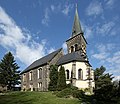Eschdorf (Dresden)
|
Eschdorf
District of the state capital Dresden
Coordinates: 51 ° 2 ′ 13 ″ N , 13 ° 56 ′ 26 ″ E
|
|
|---|---|
| Height : | 251 m |
| Area : | 7.65 km² |
| Residents : | 582 (Dec. 31, 2009) |
| Population density : | 76 inhabitants / km² |
| Incorporation : | January 1, 1994 |
| Incorporated into: | Schönfeld-Weißig |
| Postal code : | 01328 |
| Area code : | 035026 |
|
Location of the Eschdorf district in Dresden
|
|
Eschdorf is part of the town of Schönfeld-Weißig in the state capital of Dresden .
history
The place is of Germanic origin and stretches as a row village along the Schullwitzbach , a tributary of the Wesenitz . Eschdorf was first mentioned in 1317 as Eschwinsdorf (named after the first distributor of the village hall, Eschwin von Krosigh) and in 1472 it came under the rule of Wehlen . From 1547 to 1838 Eschdorf belonged to the Hohnstein office , from 1838 to 1952 to the office or the Pirna office . After the founding of the Dresden district in 1952, it belonged to this, and in 1996 it was incorporated into the newly founded district of Saxon Switzerland . On January 1, 1994, Eschdorf merged with eight other communities to form Schönfeld-Weißig, which was incorporated into Dresden on January 1, 1999.
Johann Gottlob von Quandt acquired the place in 1832 as the landlord and in 1840 built a manor in Rossendorf, which was then part of Eschdorf .
The parcel on which the Niedermühle had stood was parceled out and built on in 1708, from which the later district of Rosinendörfchen arose. The Obermühle belonged to the Bienert family, whose son Gottlieb Traugott, who was born here in 1813, founded an important milling company (today: Dresdener Mühle ) in Plauen near Dresden in 1843 .
When the Evangelical-Lutheran St. Barbara Church was rebuilt on the foundations of the previous building (first mentioned in a document in 1348, but probably built 100 years earlier) in 1886, Bienert donated the new bell. The church named after Barbara von Nicomedia has a Herbrig organ from 1838 and is a station on the "Herbrig-Orgelstraße".
In 1908 the place was connected to the Dürrröhrsdorf – Weißig railway line, which was closed again in 1951 .
In March 2007, plans to cultivate transgenic maize were abandoned after a citizens' initiative opposed this.
Obermühle Eschdorf, birthplace of Gottlieb Traugott Bienert
Sons and daughters of the place
- Johann Christoph Nicolai (1623–1681), Protestant theologian
- Johann Ludwig Gleditsch (1663–1741), bookseller and publisher
- Gottlieb Traugott Bienert (1813–1894), miller, baker and industrialist
- Gustav Gäbel (1849–1912), landowner and member of the German Reichstag
See also
literature
- Horst Torke: District of Saxon Switzerland. Meissen 1996, ISBN 3-9804714-1-1 , p. 236.
- Elly glasses in: Schönfelder Hochland between Dresden and Stolpen. Hiking map. Saxony cartography, Dresden 2006, ISBN 3-932281-14-4 .
Web links
Individual evidence
- ^ Eschdorf in the Digital Historical Directory of Saxony
- ↑ Federal Statistical Office (Ed.): Municipalities 1994 and their changes since 01.01.1948 in the new federal states. Metzler-Poeschel publishing house, Stuttgart 1995, ISBN 3-8246-0321-7 .
- ↑ The organ in the St. Barbara Church in Eschdorf (in the Dresden district of Schönfeld-Weißig). Kulturwerkstatt Stolpen e. V., accessed January 5, 2015 .
- ↑ Eschdorf remains GMO-free: GM maize cultivation in Dresden-Eschdorf has been completely withdrawn from agricultural operations. (No longer available online.) Action alliance for GM-free agriculture in Saxony, March 11, 2007, archived from the original on January 6, 2015 ; Retrieved January 5, 2015 . Info: The archive link was inserted automatically and has not yet been checked. Please check the original and archive link according to the instructions and then remove this notice.




